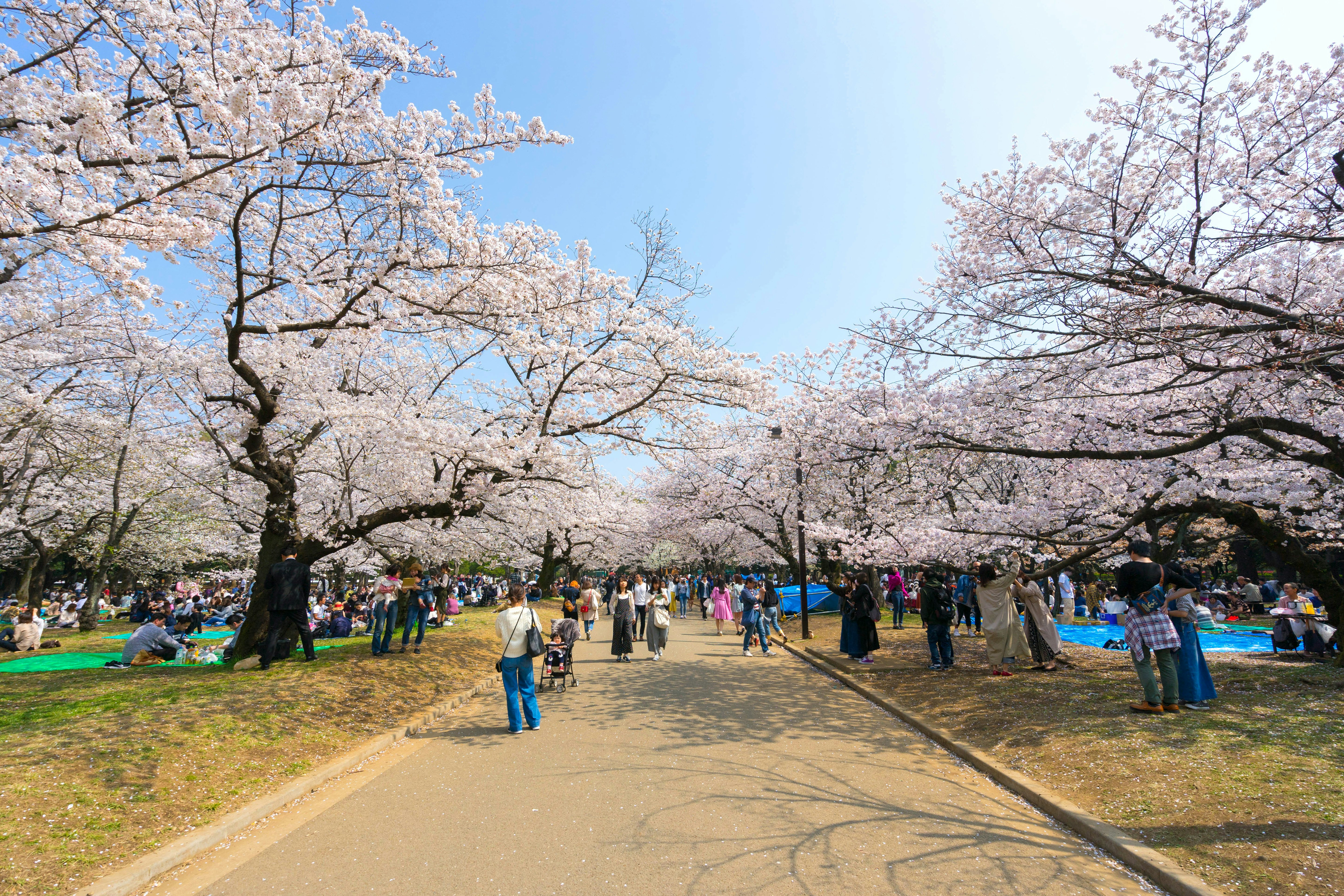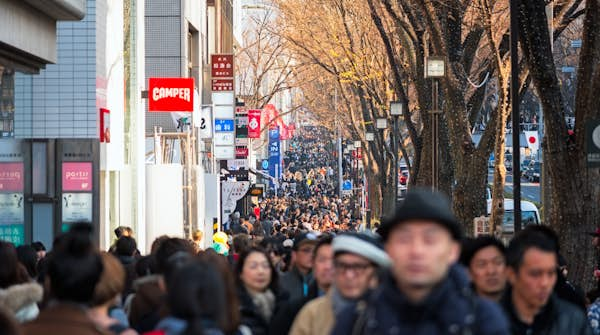Ever-fashionable Harajuku is a favorite of both Tokyoites and visitors.
On the district’s streets – many of them charmingly crooked – you’ll find trendy boutiques, stylish cafes and well-edited vintage shops. Major cultural attractions, like the Meiji-jingū (Meiji Shrine) and a much-loved green space, Yoyogi Park, also beckon.
There’s so much to do here, in fact, that it’s easy to overlook the best reason of all to visit Harajuku: to hang out. This is one of Tokyo’s best neighborhoods for meeting up, wandering around, people-watching, checking out what’s new or just chilling.
Advertisement
Situated on Tokyo’s west side, Harajuku is close to major hubs Shinjuku and Shibuya, yet refreshingly low-rise in comparison. In place of skyscrapers and digital billboards, look for acid-bright shop fronts and postmodern shopping centers.
Here’s all you need to know about Harajuku.

When should I go to Harajuku?
As in all of Tokyo, Harajuku is a year-round destination (though summers can get quite hot and humid). Weekends tend to be far more crowded than weekdays; we’d recommend the latter for optimum sightseeing and shopping.
Shops and restaurants usually open around 11am, with some cafes opening earlier. Smaller establishments may close for one day a week (often a weekday); otherwise, things are generally open throughout the week.
Harajuku is quieter after dark – and especially after the shops close for the day, usually around 8pm. If it’s nightlife you’re after, check out nearby Shibuya or Shinjuku instead.
Yoyogi Park really comes alive in the warmer months, starting with cherry-blossom season in late March or early April. The park is a top spot for hanami (cherry-blossom-viewing) parties, which tend to fill all available lawn space and run well after dark. In winter, the trees on Omote-sandō are illuminated with dazzling fairy lights.
How much time should I spend in Harajuku?
Harajuku rewards a full day of exploration. We recommend starting early, visiting Meiji-jingū first, and then working your way down Takeshita-dōri. Along the way, you’ll find plenty of cafes and casual restaurants for a coffee or lunch break. In the afternoon, explore the area around Omote-sandō. You can do a full loop, walking up the boulevard, then back through the side streets.

Is it easy to get in and around Harajuku?
Harajuku is extremely easy to get to by public transportation, and has its own stop on the convenient JR Yamanote Line, between Shibuya and Shinjuku. A handful of subway stations also serve the neighborhood, including Meijijingū-mae (Chiyoda and Fukutoshin lines) and Omote-sandō (Chiyoda, Ginza and Hibiya lines).
Advertisement
Once in Harajuku, you can walk everywhere; nothing in the neighborhood is more than a 10-minute walk from a train or subway station. In fact, Harajuku is one of Tokyo’s most pedestrian-friendly neighborhoods, with a couple of streets closed to cars, and others so narrow that drivers generally avoid them.
Top things to do in Harajuku

Make a wish at Meiji Shrine
One of Tokyo’s signature attractions, Meiji-jingū is a 20th-century rendition of a traditional Shintō shrine. Surrounded by a sacred grove, it’s as unlikely as anything you’ll see in bustling Harajuku.
It’s also a place where you can get hands-on with Japanese culture. Within the main sanctuary, you’ll see racks full of hanging wooden votive tablets surrounding a mature camphor tree. Each is penned with a wish or note of gratitude, and you’re welcome to add your own. Called ema, the votive tablets can be purchased, along with various good-luck amulets, at a kiosk nearby.
Try trendy street food on Takeshita-dōri
Takeshita-dōri is Harajuku’s famous shopping street, known for decades as the spot to scout the latest kawaii (cute) looks. More recently, it’s become the place to sample the newest (and most social-media-friendly) street-food craze. Look out for rainbow swirls of cotton candy (to match the colorful tutus sold in some of the shops?); ruby-red, sugar-glazed, skewered strawberries; and impossibly long curly fried potatoes.

See contemporary architecture along Omote-sandō
The grand boulevard that bisects Harajuku, Omote-sandō has wide sidewalks and a canopy of zelkova trees, making it among the most pleasant spots for a stroll in the city. It’s also one of the best places to see contemporary architecture: the boulevard – originally the main approach to Meiji-jingū – is lined with eye-candy boutiques and malls, most of which date to this century.
The newest structure, completed in 2024, is Harakado, a craggy, crystalline mall building with a leafy, terraced roof garden. It reflects (quite literally!) the mall across the street, Omokado, which has its own shattered-fun-house-mirror-esque entrance. Up the street, another mall, Omotesando Hills, was designed by famed Japanese architect Tadao Ando.
Go on a nostalgia trip to Kiddy Land
Harajuku’s famous toy store Kiddy Land is several stories tall, crammed with narrow aisles and stocked to the rafters with character goods. Hello Kitty is here, along with all her Sanrio pals; so are Mario, Pikachu and Sailor Moon, in the form of plushies or action figures, or decorating totes, notebooks, household goods and accessories. Need we mention that this is also an excellent place for souvenir shopping?

My favorite thing to do in Harajuku
Yoyogi Park is one of my favorite places not just in Harajuku but in all of Tokyo. While it’s far from the city’s prettiest park (my pick would be Mizumoto-kōen), Yoyogi feels like the neighborhood’s backyard – and that’s why I love it. I meet friends here. I go for walks with my husband. Sometimes, I bring a book and just sit on the lawn by myself.
There’s good coffee at either end, too, from Little Nap Coffee Stand (outside the park’s west entrance) or Sarutahiko (at The Bridge, inside Harajuku Station).

How much money do I need for Harajuku?
Harajuku offers great value, as its most compelling attractions – including Meiji-jingu, Yoyogi-kōen, Takeshita-dōri and Omote-sandō – are public ones, and free to access. What you’re more likely to spend your money on is such extras as drinks, snacks and souvenirs. And that part’s entirely up to you.
Since the neighborhood is popular with young people, there are plenty of inexpensive spots to eat, drink and shop; it’s easy to find fancier, pricier places, too. Credit cards are widely accepted, while more and more establishments take such digital payments as Apple Pay and Alipay. Still, this being Japan it’s a good idea to carry a little cash for sundries.
-
One-way ride on the JR Yamanote Line: from ¥150 (US$1)
-
Single-origin, pour-over coffee at The Bridge: from ¥500 (US$3.35)
-
Votive tablet at Meiji-jingū: ¥500 (US$3.35)
-
Brunch for two at Rainbow Pancake: around ¥3500 (US$23.50)
-
Cotton candy from Totti Candy Factory: ¥1000 ($6.70)
-
Character plushie from Kiddy Land: from ¥2500 ($16.75)
Should I stay in Harajuku?
Harajuku offers almost no places to stay, save for a handful of expensive short-term rentals. Look to neighboring Shibuya instead, where numerous options include hostels, pod hotels, boutique suites and high-rise hotels.
Is Harajuku good for kids?
Yoyogi Park is naturally great for kids – but so is Meiji-jingū, since it’s is also outdoors, and has activities kids can participate in, such as writing votive tablets. If your kids already love Japan’s panoply of cute characters, they’ll adore Kiddy Land. Meanwhile, older kids may well become enamored with Harajuku’s creative fashions and photogenic food items along Takeshita-dōri.

What should I eat in Harajuku?
Harajuku is Tokyo’s top brunch spot, and is especially known for pancakes. Try the super-fluffy kind – a local specialty – at Rainbow Pancakes, or ones stuffed with ricotta at Bills Omotesando. Expect a queue at popular places like these, especially on weekends.
Sticky-sweet crêpes have long been the quintessential Takeshita-dōri street snack, though now there is competition from newcomers like Totti Candy Factory (maker of that rainbow cotton candy). In general, Harajuku is a good place if you have a sweet tooth.

